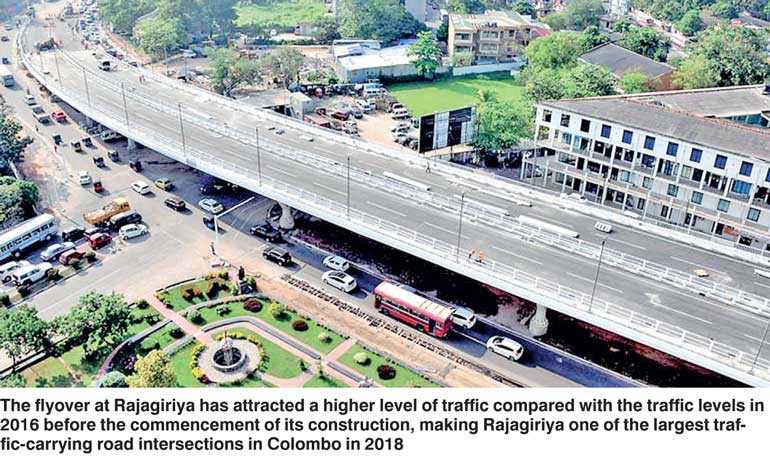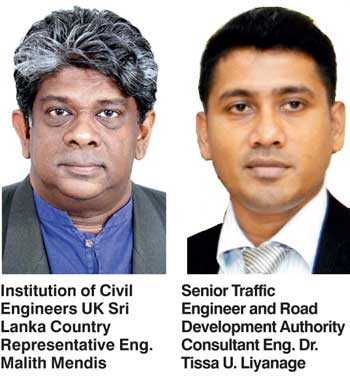Friday Dec 19, 2025
Friday Dec 19, 2025
Thursday, 19 April 2018 00:04 - - {{hitsCtrl.values.hits}}

The Sri Lanka Association of Institution of Civil Engineers (SLAICE) held an interactive lecture on ‘Traffic Management on Main Road Corridors to Colombo’. The lecture was delivered by Eng. Dr. Tissa U. Liyanage, Senior Traffic Engineer and Consultant to the Road Development Authority (RDA).
According to Dr. Liyanage, over 2.2 million passengers cross the CMC boundary through 12 main road corridors within a day in both directions. These passengers are carried by nearly 600,000 vehicles which include buses. There are 38 lanes to carry this traffic and generally nearly 50% of the passengers are carried by the bus fleet only consuming 10% of the road space on main corridors. The private passenger vehicles consume over 62% of the road space and carry only 45% of the passengers.
The traffic speeds on the main road corridors at peak and off peak hours are 5-8km/h and 20km/h respectively. These slow speeds result in long hours on the road, causing national economic loss and loss of productive time of the economically active work force. This congestion also contributes to high environment pollution and affects public health. Aggressive driver behaviour due to the frustration of long delays at junction, intersections and crossings also threaten the safety of the general road users.
One of the solutions to the congestion caused by main road junctions is construction of flyovers after studying their feasibility. There are about 15 major flyovers in the Western Province developed since year 1995. The majority of them were constructed to avoid significant delays at railway crossings. The daily savings from Dematagoda, Kelaniya and Ragama flyovers at railway crossings are estimated at 1,040, 602 and 400 vehicle hours respectively. The present value of the savings by the Kelaniya, Ganemulla and Polgahawela flyovers within a single working day are Rs. 3 million, Rs. 0.33 million and Rs. 0.38 million respectively.
These flyovers over the railway crossings have resulted in very high economic returns to the national economy by saving productive time as well as the savings in vehicle operating costs. The savings from reduced accidents too are very significant for all such locations. The emission cost has been also estimated and are significant. Almost all flyovers at the railway crossings bring high economic returns to the national economy and can be verified without any doubt.
The recently opened major flyover at Rajagiriya has now attracted higher level of traffic compared with the traffic levels in 2016 before the commencement of its construction. In 2016 it was 107,000 vehicles per day and the current total traffic movement is 176,000 vehicles a day, making Rajagiriya one of the largest traffic-carrying road intersections in Colombo in 2018.
 The traffic level in the main road corridor from Battaramulla to Ayurveda Junction has increased up to additional 45,000 vehicles a day. This has increased by a minimum of 20,000 vehicles at some sections while having recorded the maximum of 45,000 vehicles.
The traffic level in the main road corridor from Battaramulla to Ayurveda Junction has increased up to additional 45,000 vehicles a day. This has increased by a minimum of 20,000 vehicles at some sections while having recorded the maximum of 45,000 vehicles.
The traffic flow at ground level at the Rajagiriya intersection has reduced by 40%. However, since the traffic levels as a whole has increased, the signalisation has been so complicated to be phased out. Therefore, a much complicated eight phase system has been introduced to optimise the traffic signals at ground level with designed good storage capacity allocated for each approaches to the signalised intersection.
It was disclosed that the total earlier expected traffic flow on the Rajagiriya flyover in both directions per day was around 40,000 vehicles. However, the total observed in January 2018 is 56,000 vehicles per day. This is 62% more traffic than observed in 2016.
The morning peak in the Colombo direction carries only 1,500 vehicles in each hour from 7 a.m. to 10 a.m. and the hourly rate was observed as constant, whereas the peak flow at Battaramulla direction in the evening peak carries almost 3,000 vehicles/hour. Hence the peak hour congestion obviously has capacity issues which are external impacts rather than the capacity of the flyover itself.
The post-evaluation study shows the average speed on the road section from Battaramulla Town to Baseline Road over a 5.2 km distance has been observed to be improved from 3.9km/h (in 2016) to 8.2km/h (in 2018) in the morning peak hour. This brings the travel time for above section from 79 minutes in 2016 to 36 minutes in 2018. This is a saving of 43 minutes over this 5.2 km section of Sri Jayawardenapura Mawatha with the introduction of the flyover in the morning peak hours.
The speed at the off-peak hours has been drastically improved giving an average of over 40km/h which is a very significant level of service for an urban road in Colombo. So there are clear benefits from the construction of the Rajagiriya flyover.
The daily financial savings of the flyover at Rajagiriya has been estimated as Rs. 6.5 million per day in a 12-hour period as per the feasibility study carried out in year 2016. The above was the savings in the catchment including the savings in the adjoining road network that has been considered as the project impacted area. However, the project has not been completed yet and the above associated road network has not been incorporated yet as planned at the design stage. Hence the estimated benefits have not been fully achieved.
The post-evaluation study has been completed after a study over a month period of the flyover operation in January and February 2018. Therefore, the total observed daily savings only on the Sri Jayawardenapura main road by the users is Rs. 4.2 million in 2018. This is achieved despite the impacts of congestion at the Ayurveda Junction and other impacts due to non-completion of the associated traffic management plan in the adjoining roads planned at the feasibility study level.
The traffic demand management for congestion alleviation through road pricing was also discussed in the presentation and referred to how the regional countries approached for road pricing since 1970s.
The congestion pricing at Singapore, Malaysia and UK was discussed in detailed and the outcomes have been noted as the key for congestion alleviation mainly at busier road corridors peak hours and other time of the day. Different congestion pricing schemes were discussed such as area licencing schemes, entry fees, fuel pricing, entry tax, importance of two+ vehicle lanes, bus lanes, free shuttle bus services, etc.
The suitability of electronic road pricing at main road corridor entries to Colombo City, free shuttle bus services inside the Colombo City at orbital roads were identified as the possible solutions for congestion alleviation in Colombo as per the present travel setup in Colombo.
The importance of the land use policies and need of Government intervention for planning of the land use development and public investment for implementation were discussed as the most important long-term solutions for future demand management of traffic in Colombo.
Implementation of bus lanes, modernised bus fleet, Bus Rapid Transit (BRT) and Light Rail Transit (LRT) have been discussed to be the other main approaches for Traffic demand management through high capacity public transport supply to compete on the main road corridors in near future.
The need of studies for all these integrated transport supply projects through consideration of Traffic Demand Management for understanding of the threat of the negative economic impacts if the implementation of the above solutions get delayed in the next few years is clearly seen.
Speaking at the lecture, Institution of Civil Engineers UK (ICE) Sri Lanka Country Representative Eng. Malith Mendis said that the little use of railways in Sri Lanka, with approximately 7% of passenger transport and 3% of goods transport carried by rail, puts heavy pressure on roads and it is important that investment in rail is also carried out at the earliest.
Road Development Authority (RDA) Chairman Eng. Nihal Sooriyarachchi and SLAICE Chairman Eng. Dr. Kamal Laksiri were also present among the large gathering at the lecture.